#musical advent
Text
Dear Tumblr User who asked for the Matt and Trey snapbacks collection on the @mattandtrey-advent Stocking Filler Wishlist this year, Christmas came early for you, so come get your present! Hope you enjoy it, and may you have a wonderful holiday season!😁❤️🎄🧢🧢
*I tried to get one from each "event", so to speak, but had to double up and cheat for a few of the Treys (with a few of them not having snaps on the back of the hat), since Matt clearly overpowers him in this category😂





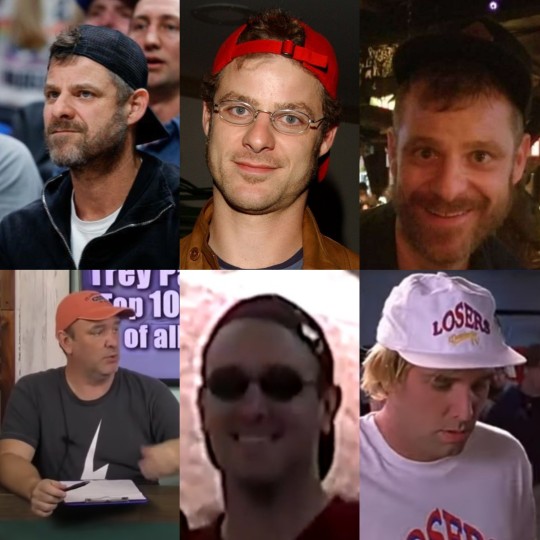




#matt stone#trey parker#matt and trey advent#matt and trey#wishlist#matt and trey advent wishlist#stocking filler#snapbacks#south park#baseketball#electric apricot#cannibal the musical#thesouthparkers#toxic mayhem
108 notes
·
View notes
Text
Gerard Way feat. Kyosuke Himuro — Safe and Sound
Final Fantasy VII: Advent Children soundtrack
(It was a damn crime this song was only in the Japanese releases of Final Fantasy VII: Advent Children and not internationally. I weep to think about all the folks who never got to see this video and only heard a snippet of the song in one of the trailers. Petition for part three of the remake trilogy to have this as its theme song.)
*The original uploader has upscaled the video to 4K to celebrate 15 years since their original upload.
#music#final fantasy#final fantasy vii#final fantasy vii: advent children#advent children#gerard way#my chemical romance#kyosuke himuro#safe and sound
61 notes
·
View notes
Text
Band!AU encore!!!
Bahamut SIN, latest single from AVALANCHE.

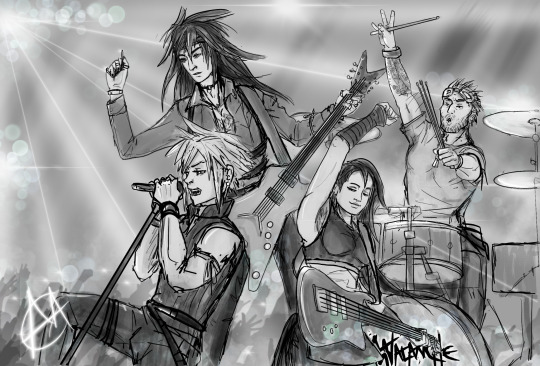
#Band!AU#so what if THAT bit from the advent children bahamut sin fight was like music. all the instruments quieting down to let cloud belt out#you know what I mean?#I am so unwell about this#the Hyperfix-ception#call me Walter white the way I keep cooking this AU#call me jjabrams’ Star Trek the way I abuse the lens flare#ff7#cloud strife#vincent valentine#tifa lockhart#cid highwind#my art
39 notes
·
View notes
Text

𝐒𝐇𝐑𝐈𝐌𝐏𝐌𝐀𝐒 𝐃𝐀𝐘 𝟔 𝐨𝐟 𝟏𝟐:
𝙲𝚘𝚣𝚢 𝙻𝚒𝚝𝚝𝚕𝚎 𝙱𝚎𝚎𝚑𝚒𝚟𝚎 𝙷𝚊𝚒𝚛
TERMS OF USE
SIMBLR | TWITCH | TWITTER
DOWNLOAD FREE ON PATREON 🦐🎄
#shrimpmas 22#sims 4 advent#my cc#I sculpted and painted this in one night while possessed by the raw energy of Katy Perry's Cozy Little Christmas Music Video
536 notes
·
View notes
Text
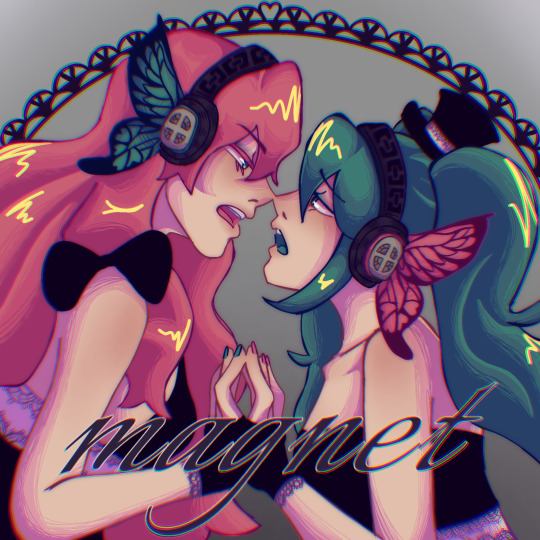
🧲💕🦋
#lavendori art#described#vocaloid#magnet vocaloid#luka megurine#megurine luka#miku hatsune#hatsune miku#lukamiku#mikuluka#no clue what theyre called. lesbience#happy lesbian visibility week by the way#music peaked in 2009 with the advent of gay singing robots#project diva#negitoro
376 notes
·
View notes
Text


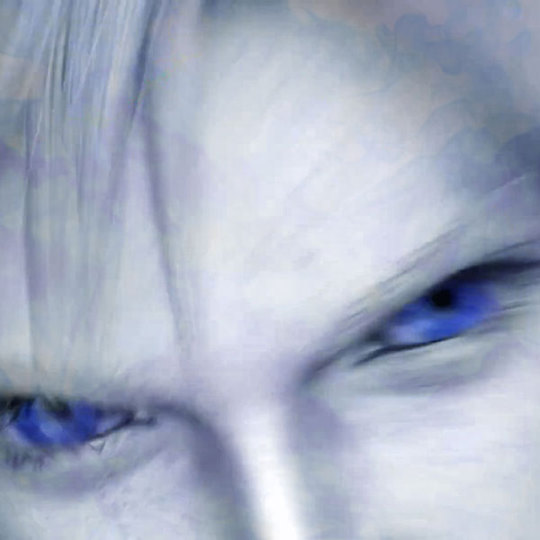

Finishing the last of FFVII Rebirth's VR challenges. Just wrapped up "To be a Hero" a couple of days ago. Taking another stab at "Bonds of Friendship" tonight. Anyway, I just had a revelation of sorts: Both fights involve Cloud plus an "assistant" character with Sephy and Zack, respectively. Both gauntlets end with Odin, who, with all due respect, is a bit of a see-you-next-Tuesday of a boss fight... BUT I am now fairly convinced that the Lord of Frenzy's position at the head of this hellish and interminable 10-round boss rush is NOT a coincidence.
Think about it. Cloud Strife's animal motif is that of Fenrisúlfur (Fenrir), the deiform wolf destined to slay Odin, the ruler of the gods, during the battle of Ragnarök at the end of all things in Norse mythology. I know that Square ran that boring-ass "chocobo hair" joke into the ground with Rebirth, to the point where newcomers to the series might actually be fooled into thinking that it's his real animal motif (and not just some tedious dad joke that has long since worn out its welcome), but prior to the new Remake series, the developers kept giving Cloud strangely villainous motifs, such as associating him with Fenrir, ostensibly one of Norse mythology's worst malefactors, or gifting him bat wings in Kingdom Hearts (unambiguously Satanic imagery).
More basic takes on this character usually involve some combination of the terms "emo", "loser", "boifailure", etc. Monosyllabic linguistic butchery aside, some of these descriptions may be partially true, but they often miss the real point: Whatever else he may be, Cloud Strife is anything but a harmless softie. If anything, post-canon, he is a psychological ticking time-bomb, one whose mental state depends largely on the company he keeps. With good friends keeping him on the straight and narrow, he'd undoubtedly be the gentlest soul. In the wrong company, however? He could easily end up becoming far more unhinged and dangerous than even his greatest nemesis could aspire to. Kitase once described him as having "a real dark side", one that presumably has less to do with Sephiroth's mind games than his own struggles against the world, ones that have rendered him a near-misanthrope, and which almost certainly would have if not for his ties with his friends and found family (Aerith, Tifa, Barret, Yuffie, etc…).
We catch glimpses of this side of Cloud's character every so often, such as when Yazoo and Loz shoot him in the back near the end of Advent Children. His reaction is telling. His face betrays not the dejection of someone ready to give up the fight, but the sheer vitriol of someone ready to tear apart anything and anyone foolish enough to get in his way. The same goes for his final confrontation with Sephiroth at the Northern Crater during the original story's ending. Sephiroth falls back on his usual intimidation tactics, not realizing that his hated enemy has long since cut his strings, and that his attempts at terrorizing and gaslighting the "nobody" who humbled him at Nibelheim are destined to fail. Cloud, though initially shocked, does not shrink away. He narrows his gaze. He knows the fight is over before it's even begun, and proceeds to deliver his foe an absolutely merciless beatdown.
Amidst the relentless meta pookie-posting and metaphorical cheek-pinching, people forget that there's a lot of hidden rage within this character. It is not a side of his personality that he is proud of, per se. But it is clearly there. More enlightened fans will understand this implicitly. One does have to wonder what missed opportunities Square had after AC/DoC for further character development in this regard. Sadly, as of the failure of Dirge of Cerberus to meaningfully advance FFVII's story, and Square's subsequent overreliance on contentious backstory additions instead, we may never know. Still, hope remains that the fandom could help fill in the blanks from time to time.
"The wild still lingered in him, and the wolf in him merely slept."
—Jack London, White Fang
#final fantasy vii#ffvii#final fantasy vii rebirth#ffvii rebirth#final fantasy vii remake#final fantasy 7#ff7#cloud strife#advent children#dirge of cerberus#crisis core#sephiroth#fenrir#norse mythology#ragnarok#lamenting a terrible waste of storytelling#btw “emo” is a terrible genre of music#whereas Advent Children clearly depicts symptoms of depression and world-weariness#weltschmerz even#words matter so use them correctly#peace out
24 notes
·
View notes
Video
youtube
(via The Advent of Panurge - Gentle Giant (1972)
15 notes
·
View notes
Text
Just another boss intro ✨
#ffxiv#final fantasy xiv#ff14#endwalker#ffxiv videos#advent of light emote is pretty sweet#also i love ff16 music#awayyyyy
89 notes
·
View notes
Text
Every step of the way, when you fall, and you have your shortcomings, He’s right there. When you have your victories, He’s right there. Give yourself grace, give yourself time to grow and appreciate it, because He’s growing with you. Every individual out here is experiencing a human life, a human experience and God is experiencing it with you. So when you go through things, He’s going with it. He’s right there with you. He’s talking to you. All you gotta do is talk back.
I’ve walked on the beach every day, and I’m talking to God, I’m just talking. Like He the homie, I swear to God, I put that on my grandmama grave, I talk to Him. Next to me, like the homie, just like the people that you grow with. I don’t care if you gotta curse, you gotta cuss, you talk to Him as if you known Him since you was born, the way He knows you. It’s the truth. It’s the truth. - Kendrick Lamar
#blm#black lives matter#kendrick lamar#kendricklamar#religion#spirituality#philosophy#quote#quotes#god#faith#bible#christian#christianity#christ#jesus#adventist#adventism#music#rap#hip hop#hip-hop#hiphop
11 notes
·
View notes
Text
Sephiroth Reborn -Advent-
Arranged by Masashi Hamauzu
#Masashi Hamauzu#Sephiroth Reborn -Advent-#Sephiroth#bizarro sephiroth#ff7#final fantasy vii#ff7 rebirth#final fantasy music#final fantasy rebirth#final fantasy vii rebirth
9 notes
·
View notes
Text
Bells 5/6
Rum Tum Tugger: Hi!… Oh, we have a new door bell?
Mistoffelees: Yes.
Rum Tum Tugger: Why?
Mistoffelees: Because we had guests and they… Well, long story short, they stole the last one.
Rum Tum Tugger: What?
Mistoffelees: Jerrie and Teazer.
Rum Tum Tugger: Right…
<prev next>
#cats the musical#cats musical#cats advent calendar#advent calendar#rum tum tugger#the rum tum tugger#mistoffelees#mr mistoffelees#mr. mistoffelees#mister mistoffelees#rum tum tugger x mr mistoffelees#tuggoffelees#magical mr mistoffelees#magical mister Mistoffelees#i think im funny
24 notes
·
View notes
Text
Tifa's Theme: A Musical Deep Dive (Part I)
(A repost from my old side blog no longer in use. All future analyses will be on this one.)

Greetings and welcome to a deep-dive into Uematsu-senpai’s masterpiece of a character theme. We will examine the rich marriage between composition and storytelling – i.e. how its musical elements express Tifa’s personality, conflictions, relationships, and story motifs. If you’ve come with zero knowledge in music theory, then my hopes are that you will leave here somewhat enriched (no prior knowledge is required). If you are a fellow geek for music, then I hope this adds insight in a storytelling sense. Ultimately, the goal of this post is to more deeply understand Tifa Lockhart.

I have divided this analysis into five sections each built on the prior: (A) the key; (B) the intro; (C) the leitmotif; (D) the original game’s use of the leitmotif; and (E) the compilation’s use of the intro and leitmotif. (The leitmotif of course being Tifa’s recurring melody, of which the first subphrase is sampled above.) Because Tumblr allows only 5 videos per post, each section will be its own post, bar for the first two which will overlap in Posts I and II.
So have your headphones/audio ready, and let us commence.
Disclaimer: these are simply my own interpretations offered with supporting evidences. I can only, to my best limited efforts, speculate as to what Uematsu did or did not intend when composing the piece.

Section (A): The Key
Tifa’s Theme is composed in the key of F major, one of the happiest keys in music. It is argued by many, in fact, to be the happiest key (though this is subjective).
“F major is at once full of peace and joy…”
– Ernst Pauer (19th C. composer).
This is a reason, I presume, that Uematsu-san chose F major for the track which represents home.
“Welcome home, Cloud,” is the first line that Tifa speaks to Cloud in the game. “I’m home” (from the Japanese dub, 唯今 – “Tadaima”) is the last thing Cloud says to Tifa at the end of Advent Children. Home is our first story motif embodied by Tifa’s character.
But of course Uematsu’s decision likely only began there.
“F major is at once full of peace and joy, but also expresses effectively a light, passing regret – a mournful, but not a deeply sorrowful feeling.”
– Ernst Pauer (quote continued).
So we have peace and joy with an undertone of mournfulness; a juxtaposition between two opposing ends of the emotion spectrum. To appreciate how the key of F major achieves this, we can benefit from a quick comparison with two other tracks.
It might surprise you that Tifa’s Theme – our warm song of home – shares the very same key notes as the tensest and most sorrowful track in Final Fantasy VII. Listen to the Cries of the Planet is composed in F major’s relative minor key: D minor. It has the same key chords as F major, yet the chords serve different functions (something we will get to later). Put another way, it has all the same notes, yet they are arranged differently. Where F major is (argued) the happiest key in music, D minor is almost universally called the key of “true sorrow.”
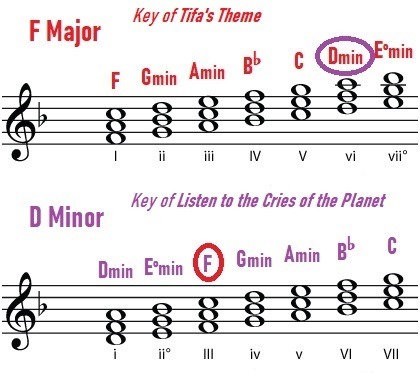
Let’s compare the two tracks here:
youtube
I wanted to begin with this little contrast for three reasons. First, to excite you non-music-theorists about the emotive power of music. Here, from our two related keys, come two completely contrasting moods. Second, we are concerned with what and how the notes will speak. Third, well… that’s a little more selfish. Listen to the Cries of the Planet is one of my favorite tracks in the game.
Our other track is One-Winged Angel – the main passage, for there are three keys in this track. It is curious that the foil character to Tifa has his fighting theme in the relative minor of hers. Like a mirror – for as Sephiroth is Cloud’s despair, Tifa is Cloud’s home. Or, to borrow a Kingdom Hearts metaphor, we’ve Cloud’s darkness against Cloud’s light. D minor is also the key of Sephiroth’s main theme – Those Chosen by the Planet.
youtube
And now, onto our deep-dive into Tifa’s Theme, which features in the original game, Advent Children, and 2020’s Remake. For now we’ll be using the piano sheets from Advent Children.
Section (B): The Intro
youtube
Tifa’s Theme begins with a tonic chord (the ‘home’ chord of our key). The further we move away from our tonic, the greater the tension (instability) will be.
By ‘home’ here I am referring to the music’s tonal center – not ‘home’ the story motif which Tifa embodies. In light of that distinction, however, with the tonic being the home point of the track and home being a story motif central to Tifa’s character, we are simultaneously referring to both.
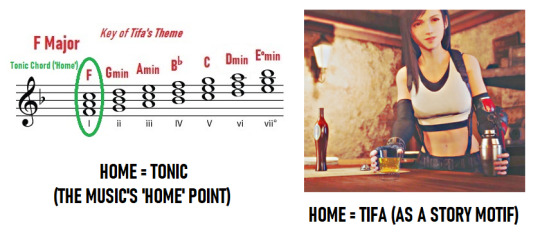
So we begin with our tonic (the F major chord) which draws us “at once [into] peace and joy.” Yet there is concurrently the hint of a mournful undertone. Only a tiny, tiny allusion – perfect for our introduction to Tifa. When we first meet her after all, we’ve no idea of the burdens locked in her heart.
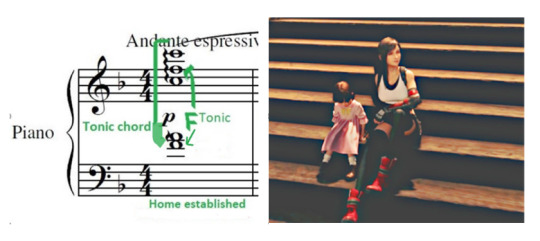
This opening tonic is presented in whole notes (the longest kind of note in common composition). In our piano version, these whole notes are arpeggiated (see the squiggly lines to their left), meaning that the chord is ‘spread’ or ‘rolled’ – the notes are played and held one after the other from the bottom up. We are at once drawn in by Tifa’s inviting warmth and we linger there.
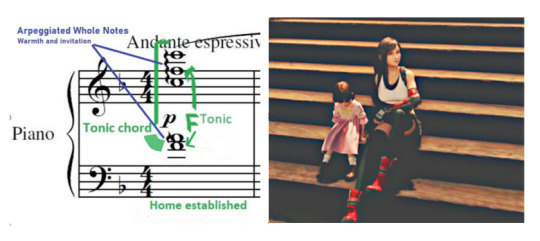
Our tonic is immediately succeeded by a chromatic chord (a chord composited of notes outside the key; notes that ‘don’t belong’). This second chord is, in fact, is the sort we would expect to find in F minor. It does not ‘belong’ in our key of F major – thus the mournful undertone which would have been further hinted is brought into direct statement. Foreshadowed is the revelation of Tifa’s burdens. She is carrying deep and unsettling secrets.

How does this work? Uematsu-san has effectively ‘borrowed’ the second chord of the F minor key and inserted it into the track’s opening chord progression. This subverts the natural expectation of our ears and creates instability – a trick he will frequently pull to toy with our emotions.

Uematsu-san then extended this borrowed chord to heighten the mournfulness by adding a 7th (a note seven intervals above the root note which further colors the mood). This enlarges the magnitude of Tifa’s mournfulness: we feel that her burdens are heavy.

The next two bars instantly carry us back to the tonic (see the harmony on the bottom stave below). This occurs in a slow fall, a faster fall, then a faster, now extended lift: the intro’s re-establishment and emphasis on the motif of home. We are never to stray from feeling at home when we are around Tifa. Simultaneously, these bars speak the ‘locking away’ of Tifa’s burdens. Her sufferings are buried quickly as her love for others is brought to the forefront.
Where our chromatic chord had an added 7th to heighten the mournfulness, our tonic build is extended with a 7th and 9ths in its lift – heightening home in a stronger comparative sense. Tifa being a home to others, in other words, overpowers her own sufferings.

There are three things we can grasp from this sequence of slow-fall to faster-fall to faster-extended-lift.
First, Tifa holds a profound motherliness toward others which outweighs thought for her own wellbeing.
Second, Tifa is insecure in dealing with her emotions, and thus strives to keep herself distracted from them. We will see this displayed right from the time of her childhood:
At 8, unable to cope with her mother’s death, she treks up the perilous mountain to try and ‘find her’ on the other side;
At 15, unwilling to face the grief of her father’s murder, she recklessly rushes to confront Sephiroth;
At 17 (in Traces of Two Pasts), she confesses to Jessie that she has been “running” from learning the truth about Nibelheim;
At 20 (in Remake), she admits she’s not even allowed herself time to decorate her apartment;
At 22 (in On the Way to a Smile), she avoids being alone in keeping extra busy with the bar and the kids during Cloud’s absence.
Thirdly – and perhaps most jarringly – Tifa embodies home despite her life being plagued by suffering.
Tifa, who lost her home and had to rebuild her life from scratch, provides a home for Cloud, Marlene, Barret, Avalanche, and later, Denzel.
Tifa, who lost her mother as a child, mothers everyone else, is for all intent Marlene’s mother, and becomes the mother of a family unit with Cloud.
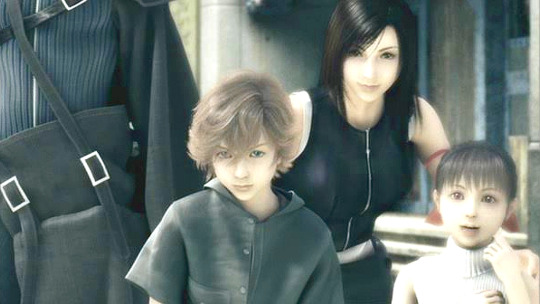
We have now travelled through the first subphrase of the intro.

youtube
We begin Subphrase Two with our opening tonic again, but this time in a quite surprising extension. Rather than adding a happy 7th or 9th to accentuate the warmth of our home chord, Uematsu-san gives us an E note which clashes with our F. Moreover, he builds the chord from this E as the bass (bottom) note.
What does this mean? Dissonance. Home is re-emphasized, but now directly with mournfulness. Although Tifa’s burdens are locked in her heart, they are ever lingering in the picture.

Compare this tonic (with the clashing E) to our opening tonic in Subphrase One. We now also have an additional climb in the harmony, which includes an added 9th. So while we can more deeply sense Tifa’s mysterious burdens (even though she’s our place of peace), extra emphasis is placed on her warmth and motherliness.
Subphrase One opening vs. Subphrase Two opening:

And so we continue Subphrase Two, following the pattern from Subphrase One. A chromatic chord follows the tonic – again ‘borrowed’ from the key of F minor – bringing Tifa’s plights to bubble once again. But before we can linger on them, we are taken back to an extended tonic chord – this time with an ‘unbelonging’ note.
From the next bar, however, things begin to shift…

Before moving onto this shift, let’s consider what we’ve covered so far. We began “at once full of peace and joy” (Tifa’s warmth pulled us toward her, pulled us home), to be immediately carried into an expression of suffering (Tifa’s secret, unsettling burdens were glimpsed). That suffering was overpowered – but not entirely suppressed – by a magnified emphasis of home (Tifa locked her burdens away behind her nurturing kindness). The suffering surfaced briefly again, and again home was accentuated (Tifa’s endless heartache continues beneath the bounds of her love).
As is very clear by now, Tifa is facing great internal conflictions. Let us dig into what the music so far has conveyed of those conflictions.
Spoken in long-value notes, our Subphrase One melodic chords convey: our peace when we are with Tifa; and Tifa’s hesitance in expressing her burdens. That they shift and waver between tonic and chromatic conveys her uncertainty.
Subphrase One conveying hesitance (in long-value notes):

Subphrase One conveying uncertainty (tonic > chromatic > tonic):

Tifa is longing to confront Cloud with the truth of his psyche. At the same time, she is uncertain of both what that will bring and what the truth is: she fears losing Cloud; and she doubts the validity of her own memories from the events he is recounting so accurately. These hesitancies, fears and doubts are gnawing at her heart, buried from the rest of the world under the forefront of home.
Subphrase Two contains less long-value notes and more wavering than Subphrase One, building the intensity of Tifa’s conflicts clashing within her. Rather than wavering from tonic to chromatic to tonic, we go from a dissonant tonic to a chromatic chord to a tonic with chromaticism to more tension in a predominant chord. I’ll get to what this means in the next post, but for now, just know it is a chord of tension.
Subphrase Two (less the final bar) building instability:

Following our new tension chord (the predominant G minor in blue) we have just one bar left to end the phrase. As it is the end of the intro as a whole, we expect to return to the tonic. But (bless Uematsu and his subversions)… the opposite happens.
Our ears expect resolution, but we are instead dragged right into the highest point of tension. Here, we are pulled into the world of the dominant chord.
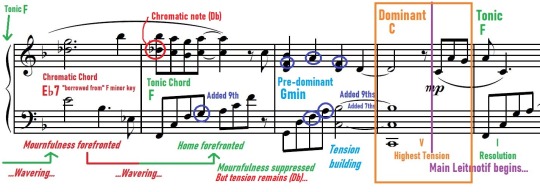
Continued in Part II here.
#final fantasy#final fantasy vii#final fantasy 7#ffvii#ff7#advent children#nobuo uematsu#tifa lockhart#cloud strife#sephiroth#avalanche#cloud x tifa#cloti#music analysis#character analysis#my deep dives
25 notes
·
View notes
Text
An earworm song I want to never get tired of hearing
youtube
#koseki bijou#hololive advent#hololive#music#memes#video#all the memes incorporated into this 😭❤️#and that the other members of advent are featured background vocals 😭😭#I love (Hololive) Advent#fuwamoco#fuwawa abyssgar#mococo abyssgard#shiori novella#nerissa ravencroft#Youtube
8 notes
·
View notes
Text

This is the timetable for the Techno Legends Floor
at MAYDAY 'united'
30. April | Dortmund / Germany
In total:
4 stages, more than 30 acts & 12 hours of pure energy
#hardfloor#acid#303#techno#roland tb-303#music#oliver bondzio#ramon zenker#tb303#hrdflr.#mayday#dortmund#dave clarke#luke slater#the advent#marco bailey#man at arms#thomas schumacher#a.d.h.s.
8 notes
·
View notes
Text
Just watched FF7 Advent Children and cried a lot only to see in the credits that GERARD FREAKING WAY OF MCR MADE THE MOVIES ENDING SONG??

#god I was NOT expecting that#but i love MCR's music so like#this makes me very very happy it's like an epic crossover for me lol#also advent children is great#i went through hell to watch it but like#it's good#also this is song is good i'll probably start listening to it#ff7#ff7 advent children#my chemical romance#gerard way#mcr gerard#ffvii#final fantasy vii advent children
25 notes
·
View notes
Text
December 8: and now for something completely different
youtube
12 notes
·
View notes